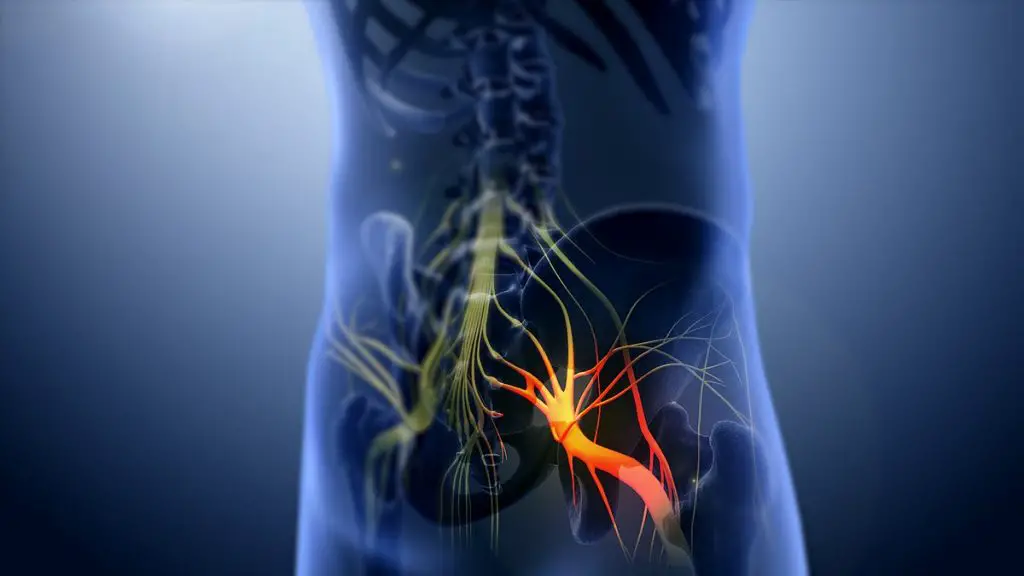The pains of sciatica can radiate throughout the lower limb to the foot. In addition to numbness and tingling, some patients complain of a “burning foot” sensation.
Where does this unpleasant feeling come from? What can be done to relieve it? We talk about it in this article.
Sciatica, short recall
The term " sciatica is commonly used to describe any pain, motor disturbances and sensory disturbances that appear on the trajectory areas of the sciatic nerve.
Symptoms can be felt anywhere along the path of the sciatic nerve: in the lower back, in the hip, in the buttock, down the leg, in the foot and even up to the toes.
People describe sciatic pain in different ways. Some people speak of sharp, throbbing pain. Others, on the other hand, speak of sensations of the type of electric shock or stabbing.
To learn more about sciatica, see next page.
Burning foot: what is the link with sciatica?
The answer to the question "Where does the burning sensation of sciatica come from?" », it is necessary to review the function of the sciatic nerve.
This nerve sends sensory signals (which help to feel sensations in your legs) and engines (which helps the muscles of your legs and feet to move), to the lower limbs.
There’s nothing quite like a sciatic nerve irritation disturbs the nerve impulses in this area, hence the appearance of pain and other sensations. This is also where the foot pain and burning sensation. The latter can be felt at the level of the heel, on the front or on the external face.
It can manifest itself in an isolated way or, in certain cases, be associated with a calf pain, in the thigh and in the lumbar region.
The patient may also experience other symptoms, such as: numbness, feeling of electric shock, weakness, etc.
5 exercises to relieve the symptoms of sciatica (in video)
Article reviewed and approved by Dr. Ibtissama Boukas, doctor specializing in family medicine You…
Calf pain: What if it came from the back? (Sciatica and more)
Article reviewed and approved by Dr. Ibtissama Boukas, doctor specializing in family medicine You…
Sciatica during pregnancy: Managing attacks (exercises)
Article reviewed and approved by Dr. Ibtissama Boukas, doctor specializing in family medicine On…
Lasègue sign: Test to detect sciatica or herniated disc
Article reviewed and approved by Dr. Ibtissama Boukas, doctor specializing in family medicine Le…
Sciatic nerve: Anatomy and route (Associated pathologies)
Article reviewed and approved by Dr. Ibtissama Boukas, doctor specializing in family medicine Le…
Sciatica and hip: what link? (explanation and advice)
The lower limbs provide locomotion, walking, jumping and body stability….
What to do then?
To be sure that the burning foot sensation comes from the sciatic nerve, you must first consult and clarify the diagnosis.
Indeed, there are other pathologies that can cause a similar sensation. Among the most common are:
- morton's neuroma
- diabetes
- metatarsalgia
- peripheral neuropathy
- alcohol abuse
- vitamin deficiency
- side effects of certain medications
- hypothyroidism
- Lyme disease
- etc.
La sciatica can be identified through a medical assessment, with the help of clinical examination and especially imaging examinations (mainly MRI which will identify irritation of the sciatic nerve).
With regard to the treatment, it relies primarily on takinganalgesics,nonsteroidal anti-inflammatory drugs and muscle relaxants. Antiepileptic drugs (such as Lyrica or Pregabalin) can also relieve burning symptoms in the foot.
In case of persistent pain, the doctor prescribes theinfiltration corticosteroid. Be careful, you should know that the infiltration will probably be carried out at the lumbar level and not in the foot, because the source of the problem most often comes from the lower back.
La physiotherapy (physiotherapy) is also a widely used approach to treat sciatica and burning sensation in the foot. For example, the physio could perform mobilizations aimed at mobilizing the sciatic nerve, and prescribe corresponding exercises.
And finally there is the surgical treatment. It is offered as a last resort when none of the usual treatments have been able to relieve the symptoms and cure the disease. It is also applied to situations of recurrence of sciatica or paralysis of the affected lower limb.
What about natural remedies?
Although they are not supported by solid scientific evidence, several natural products and home remedies are used to treat pain related to sciatica, especially for their anti-inflammatory power. It is essential to consult a doctor beforehand, mainly to avoid drug interactions and side effects.
Here is a non-exhaustive list of plants and essential oils that are effective in controlling pain and inflammation. The products are available on the site Country. Use promo code LOMBAFIT15 if you wish to obtain one of the following products, or any remedy aimed at relieving your symptoms and improving your quality of life:
- Turmeric. Thanks to its antioxidant and anti-inflammatory powers very powerful, turmeric is one of the most used plants in a culinary and therapeutic context. The composition of turmeric is essentially made of essential oils, vitamins (B1, B2, B6, C, E, K) and trace elements. But it is to its composition rich in curcumin and curcuminoids that we owe them and calm skin of this spice.
- Ginger. In addition to the special flavor it brings to the kitchen and its aphrodisiac properties, ginger is a root well known for its anti-inflammatory powers. the gingerol gives it its anti-inflammatory action. It is an active component acting on the inflammatory pain related to chronic joint inflammatory diseases, including rheumatoid arthritis, lupus, rheumatic diseases, etc. It has been proven that this active element is also effective in acting on the inflammation linked to arthritis and sciatica. Ginger also has other benefits thanks to its high potassium content and its richness in trace elements (calcium, magnesium, phosphorus, sodium) and vitamins (provitamin and vitamin B9).
- Omega-3s. Omega-3s are polyunsaturated fatty acids that play a very important role in the functioning of our body. They are provided by food in three natural forms: docosahexaenoic acid (DHA), alpha linolenic acid (ALA) and eicosapentaenoic acid (EPA). Beyond their action on the brain and the cardiovascular system, omega-3s prove very effective against inflammation. Indeed, they have the ability to act on the inflammatory mechanisms in osteoarthritis by slowing down cartilage destruction, thus they reduce the intensity of osteoarthritis pain. Sciatica, being most often linked to an inflammation secondary to a herniated disc, it can also respond to omega-3 provided it is consumed regularly.
- Lemon eucalyptus. Eucalyptus is a plant most often used in the form of herbal tea or essential oil. She would have anti-inflammatory effects which give it the ability to act on the bone and joint pain in general and the pain of sciatica in particular.
- wintergreen. Wintergreen is a shrub from which a very interesting essential oil is extracted. It is one of the most used essential oils in aromatherapy. This oil extracted from the shrub bearing the same name, is used in massage to relieve sciatica and act like a analgesic. Indeed, it provides a heating effect thanks to its ability toactivate blood circulation locally.
Remember that these products do not replace appropriate medical treatment. Rather, it should be used as a supplement, and a physician should be advised of any product consumed.
My name is Anas Boukas and I am a physiotherapist. My mission ? Helping people who are suffering before their pain worsens and becomes chronic. I am also of the opinion that an educated patient greatly increases their chances of recovery. This is why I created Healthforall Group, a network of medical sites, in association with several health professionals.
My journey:
Bachelor's and Master's degrees at the University of Montreal , Physiotherapist for CBI Health,
Physiotherapist for The International Physiotherapy Center







